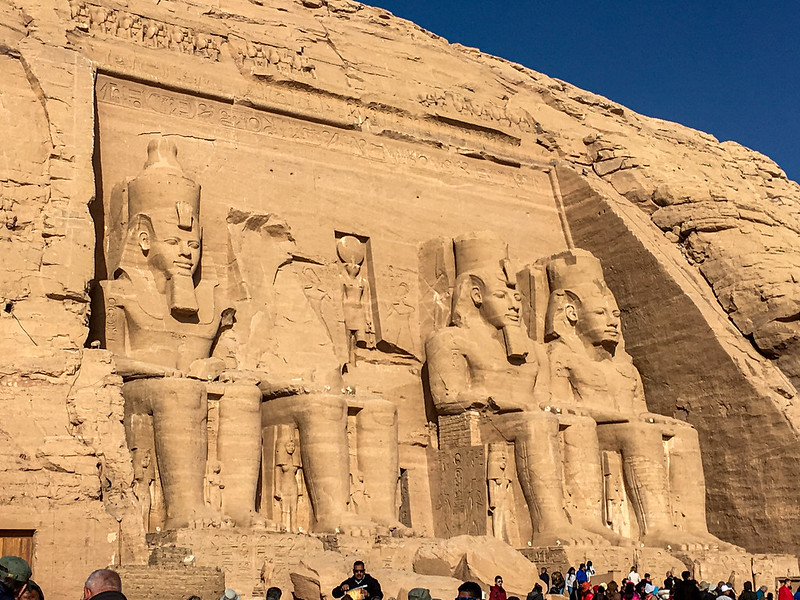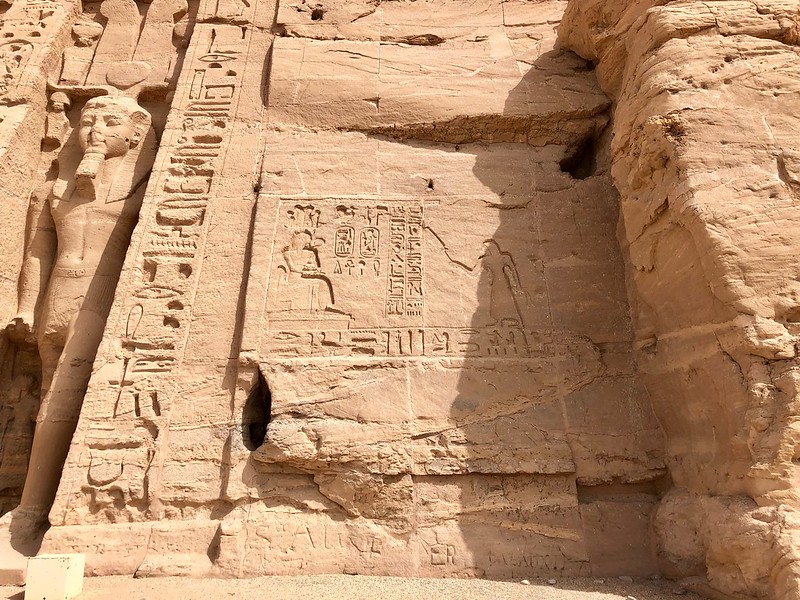Abu Simbel is the quintessential place to visit for anybody craving an authentic slice of Egypt. A 24-hour trip here is a deep dive into the history of this magnificent, ancient country.

Abu Simbel Temple, Aswan, Egypt (Photo: cattan2011 via Flickr/ CC BY 2.0)
At the height of Egypt’s golden era, Ramses II built more monuments than any other Egyptian king in history. Abu Simbel, south of Aswan and just north of Sudan, is where you’ll find some of these ancient monuments. Here, the magnificent Great Temple of Ramses II and its companion known as the Small Temple overlook Lake Nasser in the Nubia region, serving as a reminder of the pharaoh’s powerful reign.
But these temples were originally built further down the Nile. When flooding from the Aswan High Dam threatened destruction in the 1960s, each temple was carefully disassembled and moved to its current location. The temples themselves weren’t uncovered until 1813 when shifting desert sands revealed the ruins to Swiss explorer Jean-Louis Burckhardt. Now, Abu Simbel is part of the UNESCO World Heritage Site of Nubian Monuments, which includes the Sanctuary of Isis at Philae.
While there’s a small village built up around the temples, most people day trip here from Aswan. But why rush it? Spend the night and see the sunrise over the temples for a glimpse of the same morning light that Ramses II may have witnessed creeping over his kingdom three millennia ago.
THINGS TO DO
The star attraction in Abu Simbel is the Great Temple of Ramses II. The Great Temple was carved out of the mountain on the west bank of the Nile over 3,000 years ago (between 1274-1244 BC) and was meant to immortalize the pharaoh. It worked. The four colossal statues of Ramses II guarding the entrance of the inner temple are still an intimidating presence to anyone visiting for the first time and serve as a strong testament to Ramses II’s powerful reign. Between the pharaoh’s legs are larger-than-life statues of royal family members. Inside, the Hypostyle Hall is filled with 10-meter tall Osiris statues and mural reliefs of the king in battle, while the ceiling is painted with flying vultures. From there, you’ll find many other chambers and vestibules to explore.
The Temple of Hathor and Nefertari next to the Great Temple is also known as the Small Temple. This monument is dedicated to Queen Nefertari, Ramses II’s most cherished wife, and the colossal statues outside the temple show Nefertari as Hathor—goddess of the sky, women, fertility, and love. Ramses II is also depicted here, and unusually, he is the same height as his queen. Beyond the main entrance, the temple is laid out much like the Great Temple, with a relief-adorned Hypostyle Hall leading to side chambers and an inner sanctuary. When you see these temples, it’s hard to imagine they were cut down into stone cubes and moved further up the Nile to their final resting spot—from the outside, it appears that not a single stone is out of place. Both of these temples are easy to visit in one day, although the site does get congested with visitors later in the morning.

Temple of Hathor and Nefertari (Photo: Warren Le May via Flickr/CC0 1.0)
The Sound & Light Show happens nightly in Abu Simbel, and although it may sound kitschy, the dazzling lights offer a captivating, unique view of the sacred temples. If you’re lucky enough to be here on February 21 or October 21, be part of the Abu Simbel Sun Festival and watch for the rays of sunlight illuminating the divine figures of the Great Temple’s Sanctuary. This phenomenon was actually meant to occur a day earlier (widely believed to celebrate Ramses II’s birthday and coronation day), but the temple’s axis was slightly thrown off during its relocation.
With a bit more time in Abu Simbel, Egyptophiles shouldn’t pass up the opportunity to visit the nearby Temple of Wadi El-Sebua. In Arabic, the name means “Valley of Lions,” which is an apt description for the row of sphinxes leading up to the temple. This temple was also built during the reign of Ramses II, but it wasn’t as popular as the others and fell to neglect in the 1960s. Now, you can explore the hypostyle hall, the sanctuary, and the courtyards.
WHERE TO STAY
There are a few hotels at the Abu Simbel site for people who want to stay and watch the evening light show or to watch the sun come up, but most people come here as a day trip from Aswan. Seti Abu Simbel Lake Resort is located right at the foot of the Great Temple with views over Lake Nasser. Lush gardens, a luxurious pool, and comfortable Nubian-style rooms will put the final touches on your stay in Abu Simbel.
Eskaleh Nubian House is another excellent option for a quiet retreat after a busy day exploring the temples. Accommodations are basic, but the hospitality of the owners is exceptional—you shouldn’t pass up the opportunity to dine with them, if possible. Nubian Lake House, a quaint eco-lodge, is another quiet option. Each room comes equipped with a terrace overlooking the town.
EAT & DRINK
There are several food stalls around the temples and a few places to eat in the village, but as Abu Simbel is primarily a tourist hub, you may want to bring your own snacks and beverages. Abu Simbel is simply not well known for its culinary offerings. Along the town’s main road are a few cafes, including Toya, with a quiet garden area where you can drink coffee and have a full breakfast. For a full meal, Wady El Nile and the Nubian Oasis both offer traditional Egyptian cuisine. Try koshari, the national dish consisting of pasta, rice, and lentils cooked in a spicy tomato sauce. Ful medames (fava beans, mashed) and corchorus (a veggie dish) are two other must-try meals.
Otherwise, take advantage of your hotel’s dining options. At Eskaleh Nubian House you’ll be treated to homestyle Nubian cooking, while Seti Abu Simbel Lake Resort has a full buffet and à la carte options. At their pool bar you can enjoy a refreshing cocktail or mocktail while luxuriating in the sun. The fish tagine at Nubian Lake House is also a must-try.